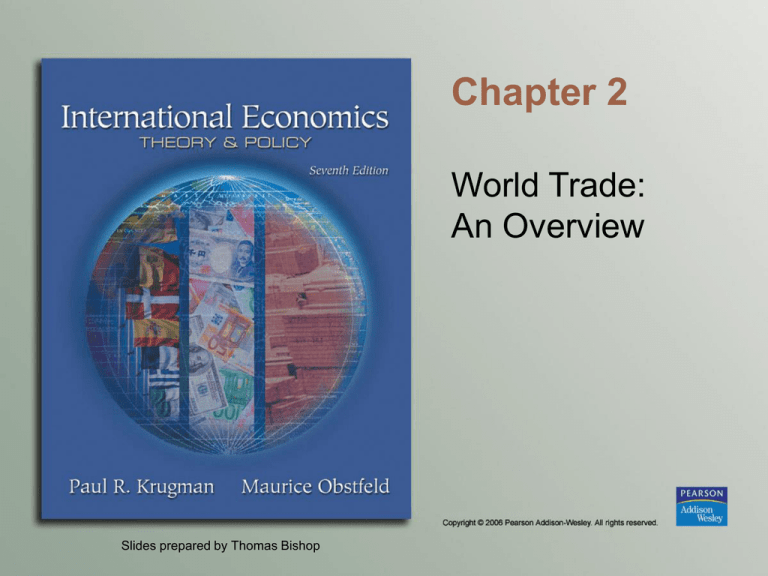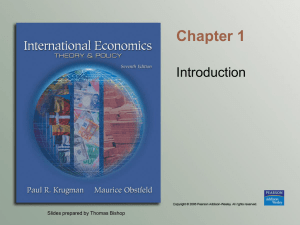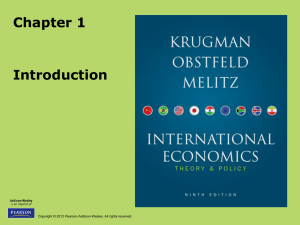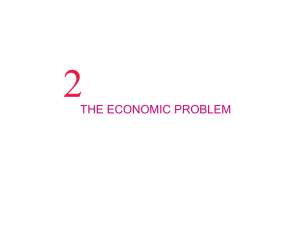
Chapter 2
World Trade:
An Overview
Slides prepared by Thomas Bishop
Preview
• The largest trading partners of the US
• Gravity model:
influence of an economy’s size on trade
distance and other factors that influence trade
• Borders and trade agreements
• Globalization, then and now
• Changing composition of trade
• Multinational corporations and outsourcing
Copyright © 2006 Pearson Addison-Wesley. All rights reserved.
2-2
Who Trades with Whom?
• The 5 largest trading partners with the
US in 2003 were Canada, Mexico, China,
Japan and Germany.
• The total value imports from and exports
to Canada in 2003 was almost $400
billion dollars.
• The largest 10 trading partners with the
US accounted for 68% of the value of US
trade in 2003.
Copyright © 2006 Pearson Addison-Wesley. All rights reserved.
2-3
Who Trades with Whom? (cont.)
Copyright © 2006 Pearson Addison-Wesley. All rights reserved.
2-4
Size Matters: The Gravity Model
• 3 of the top 10 trading partners with the US
in 2003 were also the 3 largest European economies:
Germany, UK and France.
• These countries have the largest gross domestic
product (GDP) in Europe.
GDP measures the value of goods and services
produced in an economy.
• Why does the US trade most with these European
countries and not other European countries?
Copyright © 2006 Pearson Addison-Wesley. All rights reserved.
2-5
Size Matters: The Gravity Model (cont.)
• In fact, the size of an economy is
directly related to the volume of imports
and exports.
Larger economies produce more goods and
services, so they have more to sell in the
export market.
Larger economies generate more income from
the goods and services sold, so people are able
to buy more imports.
Copyright © 2006 Pearson Addison-Wesley. All rights reserved.
2-6
Size Matters: The Gravity Model (cont.)
Copyright © 2006 Pearson Addison-Wesley. All rights reserved.
2-7
The Gravity Model
Other things besides size matter for trade:
1. Distance between markets influences transportation
costs and therefore the cost of imports and exports.
Distance may also influence personal contact and
communication, which may influence trade.
2. Cultural affinity: if two countries have cultural ties, it
is likely that they also have strong economic ties.
3. Geography: ocean harbors and a lack of mountain
barriers make transportation and trade easier.
Copyright © 2006 Pearson Addison-Wesley. All rights reserved.
2-8
The Gravity Model (cont.)
4. Multinational corporations: corporations spread
across different nations import and export many
goods between their divisions.
5. Borders: crossing borders involves formalities that
take time and perhaps monetary costs like tariffs.
These implicit and explicit costs reduce trade.
The existence of borders may also indicate the existence of
different languages (see 2) or different currencies, either of
which may impede trade more.
Copyright © 2006 Pearson Addison-Wesley. All rights reserved.
2-9
The Gravity Model (cont.)
• In its basic form, the gravity model assumes that only
size and distance are important for trade in the
following way:
Tij = A x Yi x Yj /Dij
• where
Tij is the value of trade between country i and country j
A is a constant
Yi the GDP of country i
Yj is the GDP of country j
Dij is the distance between country i and country j
Copyright © 2006 Pearson Addison-Wesley. All rights reserved.
2-10
The Gravity Model (cont.)
• In a slightly more general form, the gravity model that
is commonly estimated is
Tij = A x Yia x Yjb /Dijc
where a, b, and c are allowed to differ from 1.
• Perhaps surprisingly, the gravity model works fairly
well in predicting actual trade flows, as the figure
above representing US–EU trade flows suggested.
Copyright © 2006 Pearson Addison-Wesley. All rights reserved.
2-11
Distance and Borders
• Estimates of the effect of distance from the
gravity model predict that a 1% increase in
the distance between countries is associated
with a decrease in the volume of trade of
0.7% to 1%.
Copyright © 2006 Pearson Addison-Wesley. All rights reserved.
2-12
Distance and Borders (cont.)
• Besides distance, borders increase the cost and time
needed to trade.
• Trade agreements between countries are intended to
reduce the formalities and tariffs needed to cross
borders, and therefore to increase trade.
• The gravity model can assess the effect of trade
agreements on trade: does a trade agreement lead to
significantly more trade among its partners than one
would otherwise predict given their GDPs and
distances from one another?
Copyright © 2006 Pearson Addison-Wesley. All rights reserved.
2-13
Distance and Borders (cont.)
• The US has signed a free trade agreement
with Mexico and Canada in 1994, the North
American Free Trade Agreement (NAFTA).
• Because of NAFTA and because Mexico
and Canada are close to the US, the
amount of trade between the US and its
northern and southern neighbors as a fraction
of GDP is larger than between the US and
European countries.
Copyright © 2006 Pearson Addison-Wesley. All rights reserved.
2-14
Distance and Borders (cont.)
Copyright © 2006 Pearson Addison-Wesley. All rights reserved.
2-15
Distance and Borders (cont.)
• Yet even with a free trade agreement between
the US and Canada, which use a common
language, the border between these countries
still seems to be associated with a reduction
in trade.
Copyright © 2006 Pearson Addison-Wesley. All rights reserved.
2-16
Distance and Borders (cont.)
Copyright © 2006 Pearson Addison-Wesley. All rights reserved.
2-17
Distance and Borders (cont.)
Copyright © 2006 Pearson Addison-Wesley. All rights reserved.
2-18
Has the World Become “Smaller”?
• The negative effect of distance on trade according
to the gravity models is significant, but it has grown
smaller over time due to modern transportation
and communication.
Wheels, sails, compasses, railroads, telegraph, steam
power, automobiles, telephones, airplanes, computers, fax
machines, internet, fiber optics,… are technologies that
have increased trade.
• But history has shown that political factors, such as
wars, can change trade patterns much more than
innovations in transportation and communication.
Copyright © 2006 Pearson Addison-Wesley. All rights reserved.
2-19
Has the World Become “Smaller”? (cont.)
• There were two waves of globalization.
1840–1914: economies relied on steam power,
railroads, telegraph, telephones. Globalization was
interrupted and reversed by wars and depression.
1945–present: economies rely on telephones,
airplanes, computers, internet, fiber optics,…
Copyright © 2006 Pearson Addison-Wesley. All rights reserved.
2-20
Has the World Become “Smaller”? (cont.)
• Only in the last few decades has international
trade become more important to the British
economy than it was in 1910.
• Even today, international trade is less
important for the US than it was to the UK
before 1910.
Copyright © 2006 Pearson Addison-Wesley. All rights reserved.
2-21
Has the World Become “Smaller”? (cont.)
Copyright © 2006 Pearson Addison-Wesley. All rights reserved.
2-22
Changing Composition of Trade
• What kinds of products do nations currently trade,
and how does this composition compare to trade in
the past?
• Today, most of the volume of trade is in manufactured
products such as automobiles, computers, clothing
and machinery.
Services such as shipping, insurance, legal fees and
spending by tourists account for 20% of the volume of trade.
Mineral products (e.g., petroleum, coal, copper) and
agricultural products are a relatively small part of trade.
Copyright © 2006 Pearson Addison-Wesley. All rights reserved.
2-23
Changing Composition of Trade (cont.)
Copyright © 2006 Pearson Addison-Wesley. All rights reserved.
2-24
Changing Composition of Trade (cont.)
• In the past, a large fraction of the volume of trade
came from agricultural and mineral products.
In 1910, Britain mainly imported agricultural and mineral
products, although manufactured products still represented
most of the volume of exports.
In 1910, the US mainly imported and exported agricultural
products and mineral products.
In 2002, manufactured products made up most of the volume
of imports and exports for both countries.
Copyright © 2006 Pearson Addison-Wesley. All rights reserved.
2-25
Changing Composition of Trade (cont.)
Copyright © 2006 Pearson Addison-Wesley. All rights reserved.
2-26
Changing Composition of Trade (cont.)
• Developing countries, or low and middleincome countries, have also changed the
composition of their trade.
In 2001, about 65% of exports from developing
countries were manufactured products, and only
10% of exports were agricultural products.
In 1960, about 58% of exports from developing
countries were agricultural products and only
12% of exports were manufactured products.
Copyright © 2006 Pearson Addison-Wesley. All rights reserved.
2-27
Changing Composition of Trade (cont.)
Copyright © 2006 Pearson Addison-Wesley. All rights reserved.
2-28
Multinational Corporations
and Outsourcing
• Before 1945, multinational corporations
played a small role world trade.
• But today about one third of all US exports
and 42% of all US imports are sales from
one division of a multinational corporation
to another.
Copyright © 2006 Pearson Addison-Wesley. All rights reserved.
2-29
Multinational Corporations
and Outsourcing (cont.)
• Outsourcing occurs when a firm moves
business operations out of the domestic
country.
The operations could be run by a subsidiary of a
multinational corporation.
Or they could be subcontracted to a foreign firm.
• Outsourcing of either type increases the
amount of trade.
Copyright © 2006 Pearson Addison-Wesley. All rights reserved.
2-30
Summary
1. The 5 largest trading partners with the US are
Canada, Mexico, China, Japan and Germany.
2. The largest economies in the EU undertake the
largest fraction of the total trade between the EU
and the US.
3. The gravity model predicts that the volume of
trade is directly related to the GDP of each trading
partner and is inversely related to the distance
between them.
Copyright © 2006 Pearson Addison-Wesley. All rights reserved.
2-31
Summary (cont.)
4.
Besides size and distance; culture, geography,
multinational corporations and the existence of
borders influence trade.
5.
Modern transportation and communication have
increased trade, but political factors have influenced
trade more in history.
6.
Today, most trade is in manufactured goods, while
historically agricultural and mineral products made
up most of trade.
Copyright © 2006 Pearson Addison-Wesley. All rights reserved.
2-32
Copyright © 2006 Pearson Addison-Wesley. All rights reserved.
2-33
Copyright © 2006 Pearson Addison-Wesley. All rights reserved.
2-34







